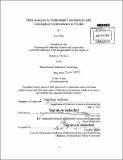Data analysis to understand coordination and topological environments in oxides
Author(s)
Chen, Tina (Tina J.)
DownloadFull printable version (6.939Mb)
Other Contributors
Massachusetts Institute of Technology. Department of Materials Science and Engineering.
Advisor
Gerbrand Ceder.
Terms of use
Metadata
Show full item recordAbstract
Local coordination and topology of ions determine several important properties of materials, including electronic structure, migration barrier, and diffusivity. In this thesis, we employ the Materials Project Database to investigate the coordination preferences of cations and topology of coordination polyhedra in oxides. We calculate the coordination environment preferences of several common cations in oxides, identifying lithium, sodium, calcium, and magnesium ion's preferred coordination numbers are 4- fold/6-fold, 6-fold, 6-fold, and 6-/4-fold coordination respectively. We also develop a method to quantify the connectivity between two polyhedra and determine whether they are point-sharing, edge-sharing, or face-sharing. We find that 4-fold coordinated lithium polyhedra mainly point-share while the 6-fold coordinated lithium polyhedra connectivites are face-sharing. We then build a tool to identify and insert "empty polyhedra" (i.e. coordination polyhedra which are bounded by ions but contain no central ion) which can help to provide a better descriptor of the structure topology. We also find that most connections with lithium polyhedra are with empty polyhedra and that in a connected set of two lithium polyhedra and one empty polyhedron, the coordination polyhedra tend to be either 6-4-6 or 4-6-4 with the empty polyhedron in the center. Finally, we utilize the database to evaluate Pauling's first and second rules, which are guidelines for current understanding of coordination and topology, and observe that the rules are generally accurate only within a 30% error margin.
Description
Thesis: S.B., Massachusetts Institute of Technology, Department of Materials Science and Engineering, 2015. Cataloged from PDF version of thesis. Includes bibliographical references (pages 47-48).
Date issued
2015Department
Massachusetts Institute of Technology. Department of Materials Science and EngineeringPublisher
Massachusetts Institute of Technology
Keywords
Materials Science and Engineering.